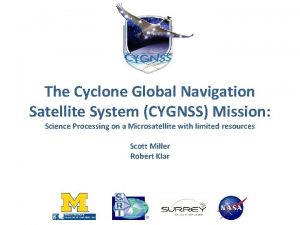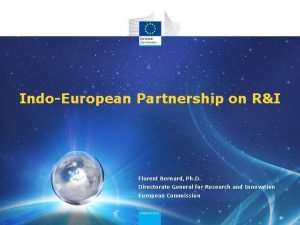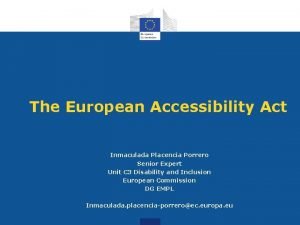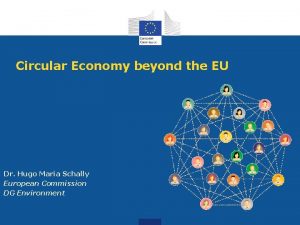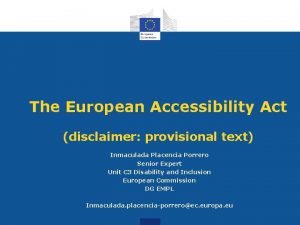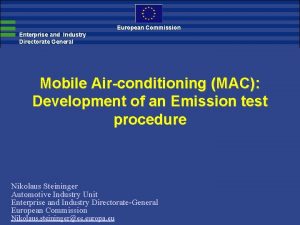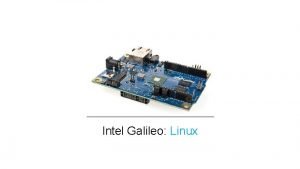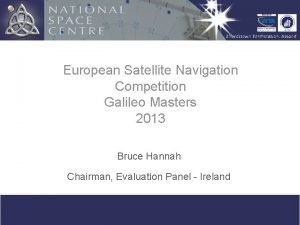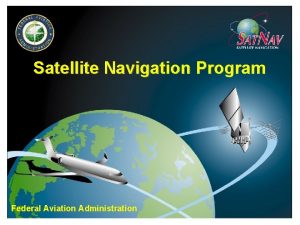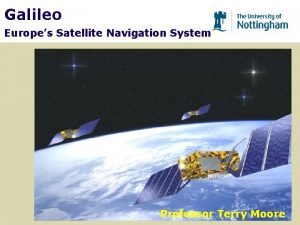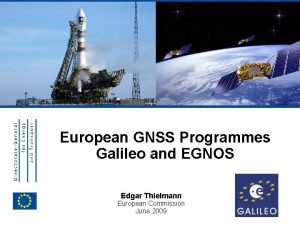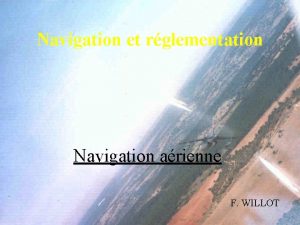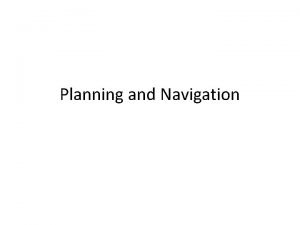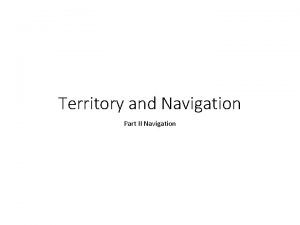European Commission Galileo The European Satellite Navigation Program
















- Slides: 16

European Commission Galileo The European Satellite Navigation Program Presentation GNSS 4. 3 by Markus Bruns European Commission Directorate General for Energy and Transport Directorate-General for Energy and Transport Information/Communication 1

What is Galileo? The European satellite radionavigation programme Galileo will be a new navigation satellite constellations fitting into the global concept of GNSS and transmitting positioning signals to a variety of users, among them civil aviation. Galileo is based on a constellation of 30 satellites placed in medium earth orbit and continuously covering the entire surface of the earth. How far is Galileo? 2002 -2005 2006 -2007 From 2008 The definition phase has already been completed. Development and validation phase Deployment phase Commercial operation phase Directorate-General for Energy and Transport Information/Communication 2

Concept “In the same way that no one nowadays can ignore the time of day, in the future no one will be able to do without knowing their precise location. ” 30 satellites around the earth safety of life general public Local element Users Directorate-General for Energy and Transport commerce Information/Communication 3

WAAS (US) & EGNOS & MSAS (Japan): first step towards service guarantees EGNOS: Complement to GPS and GLONASS with 2 Inmarsat / 1 Artemis Transponders First step towards GALILEO Interoperable with WAAS and MSAS GPS-type (Ranging) Signal Correction signals Integrity higher availability meter accuracy Directorate-General for Energy and Transport service guarantee Information/Communication 4

EGNOS Test Bed Directorate-General for Energy and Transport Information/Communication 5

EGNOS service area AREA CEAC Directorate-General for Energy and Transport Information/Communication 6

Role of EGNOS in GALILEO üEGNOS is the first step to Galileo and part of the European Satellite Navigation Strategy. It will become operational in early 2004 and is partially funded by air traffic services providers. EGNOS will remain fully compliant with the ICAO SBAS SARPS and be interoperable with WAAS. üEGNOS will pave the way and reduce the risks for GALILEO in different domains: ØTechnical aspects (I. e. integrity). ØOperational experience. ØCertification process. ØInstitutional framework…. . Directorate-General for Energy and Transport Information/Communication 7

Aviation applications l l l Gate to gate navigation Service guarantees and liability More efficient flight routing leads to fuel savings Better tracking of aircraft enhances safety Closer spacing of planes increases airspace capacity € 800 M market by 2003 Directorate-General for Energy and Transport Information/Communication 8

Civil Aviation and GALILEO u Key interests for civil aviation in a GNSS service relying on redundant, interoperable and multi-frequency GALILEO and GPS constellations è Improved performance, with the positive impact to reduce complexity and cost. è Redundancy (No common mode failures) è Improved è Ease robustness to interference World Wide acceptance of this new technology Directorate-General for Energy and Transport Information/Communication

GPS/EGNOS and GALILEO ® Complementarity ¬ • cater for alternative in case of system failure of one system and • allow for New and Complementary Services New Services thanks to service guarantees and certification Complementary Services thanks to higher availability and confidence Directorate-General for Energy and Transport Information/Communication 10

The development phase has been launched On 26 March, the Transport Council agreed on the Regulation governing the statutes of the Joint Undertaking. . . Commission to establish the Joint Undertaking as soon as possible together with ESA Private sector participation possible at a later stage …and on the release of the remaining € 450 m to fund the development phase € 450 m as Trans-European Network project with the Joint Undertaking as beneficiary (in addition to € 100 m already released and € 550 m ESA contribution) annual payments from 2002 to 2005 Directorate-General for Energy and Transport Information/Communication 11

Economic aspects of GALILEO Costs of the system Development and deployment costs are put at € 3. 2 billion. That is the price of 150 km of semi-urban motorway or of just one track of the main tunnel for the future high-speed rail link between Lyon and Turin. Economic viability Cost/benefit ratio: 4. 6 over 20 years, taking air and sea transport alone. No other infrastructure project in Europe can match a ratio like that. Jobs created: 140 000 Market created: € 9 billion/year Society as a whole will benefit, not just investors in the programme. For example, improving air traffic control will save passengers time and airlines money and cut pollution by emissions from aircraft. Directorate-General for Energy and Transport Information/Communication 12

The GALILEO management structure The Joint Undertaking Role For the first time ever this form of company provided for under Article 171 of the Treaty is to be set up. It will allow a single effective management body for Galileo combining public and private funding. To establish management structures and a business plan. To harness public and private Structure Set up: 2002 -2005 funding. Capital: about € 20 million To publish calls for tenders to set Founder members: Community, European up the system. Space Agency To launch the first satellites, in partnership with the ESA. Other Members: European Investment Bank any business subscribing € 20 million or more (€ 1 million for SMEs) after the selection of a future concessionaire Directorate-General for Energy and Transport Information/Communication 13

JU: How it works Founding Members European Community (Commission) Supervisory Board Possible Future Members European Space Agency European Investment Bank Private companies Other ESA Pb-Nav (ESA Member States) (EU Member States) Here others could potentially join in Administrative Board Joint Undertaking Executive Committee Director Subcontracting Infrastructure (ground / space) Application development Directorate-General for Energy and Transport Preparation of deployment and operation Information/Communication 14

GALILEO and the ICAO GNSSP - EGNOS and GALILEO are the European Unions contributions to the world wide concept of GNSS in particular for the aviation sector. - EC and ESA will continue to provide all necessary information to ICAO in order to standardise GALILEO. - Safety and robustness will be the issues for the future work of standardising new elements for GNSS. A GNSS consisting of GALILEO, GPS and GLONASS should be able to meet these requirements. - The Air Navigation Conference next year will reassess the GNSS concept. It will be important to demonstrate that the GNSS concept will be the future for air navigation. Directorate-General for Energy and Transport Information/Communication 15

Open to international co-operation • Galileo has been designed as global system with build-in regional and local enhancement capabilities • Negotiations with the United States and Russian Federation are underway • other parties expressed interest and some participated already in the definition studies Directorate-General for Energy and Transport Information/Communication 16
 Cyclone global navigation satellite system
Cyclone global navigation satellite system Recommendations of secondary education commission 1952-53
Recommendations of secondary education commission 1952-53 Graduated commission example
Graduated commission example Traineeship office european commission
Traineeship office european commission Martine deprez european commission
Martine deprez european commission European commission
European commission Brendan devlin european commission
Brendan devlin european commission Adam romanowski european commission
Adam romanowski european commission Florent bernard european commission
Florent bernard european commission Inmaculada placencia porrero european commission
Inmaculada placencia porrero european commission European commission sustainable finance
European commission sustainable finance European commission
European commission Dr hugo maria
Dr hugo maria European commission
European commission Inmaculada placencia porrero european commission
Inmaculada placencia porrero european commission Cost benefit analysis european commission
Cost benefit analysis european commission European commission
European commission
